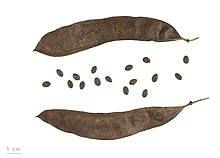Ordinary Judas tree
| Ordinary Judas tree | ||||||||||||
|---|---|---|---|---|---|---|---|---|---|---|---|---|

Common Judas Tree ( Cercis siliquastrum ) |
||||||||||||
| Systematics | ||||||||||||
|
||||||||||||
| Scientific name | ||||||||||||
| Cercis siliquastrum | ||||||||||||
| L. |
The Ordinary Judas tree ( Cercis siliquastrum ), also briefly Judas tree called, is a plant from the kind of Judas trees ( Cercis ) in the family of legumes (Fabaceae). It is native to southern Europe and the Middle East and is used as an ornamental plant.
description
Appearance and leaf
The common Judas tree grows as a deciduous, large shrub or as a small, often multi-stemmed tree and reaches heights of 4 to 8, more rarely 10 to 13 meters. The grayish to brownish, rough bark is cracked to furrowed or scaly.
The alternate leaves are stalked. The simple, bare and thin, papery leaf blade is heart-shaped to kidney-shaped with a diameter of up to 13 cm, often wider than long and entire, as well as rounded to blunt or indented, rarely slightly pointed or pointed. The fresh leaf shoots are often still bronze and the autumn color is yellow. The small stipules fall off early.
Inflorescence and flower
The Judas tree is one of the few woody plants found in Europe in which the inflorescences emerge on older trunk parts ( cauliflora ), they appear before the leaves appear on the perennial wood. The short racemose , tufted inflorescences only contain up to about ten flowers. The bracts are scale-like. The hermaphroditic, longer-stalked flowers are zygomorphic and five-fold with a double flower envelope . The five reddish to purple sepals are bell-shaped fused with five equal calyx teeth. The five purple-pink petals form a 1.2 to 1.5 cm long crown, which stand together in a different form of bud cover (cochlear ascending) than the typical butterfly flowers. There are ten free stamens . All dust bags are the same. The single, stalked and elongated, middle-sized carpel contains many ovules . The stylus is slim. The pollination is done for example by bees .
Fruit and seeds
The leathery, glabrous legume , which opens with two flaps and is pointed, is elongated and flattened with a length of 7.5 to 9.5 cm and a width of 1.7 to 1.8 cm; the upper seam is winged narrow. The legume constricted to the seeds contains many egg-shaped, brown and smooth, sometimes somewhat flattened, seeds about 5–6 millimeters long.
Occurrence
The natural distribution of the common Judas tree extends over Mediterranean countries in southern Europe and the Middle East .
The common Judas tree prefers calcareous soils and altitudes below 400 meters. It prefers light forests as a location, but also occurs in shrub form as pioneer vegetation on stony soils.
use
The common Judas tree is used as an ornamental wood . Several cultivated forms are known: 'Alba' with white flowers, 'Bodnant' with dark pink flowers and 'Rubra' with dark red flowers (selection).
The very hard wood is used as plywood due to its beautiful grain .
The flowers can be eaten raw and are a sweet and sour enrichment and decoration for every salad. The flower buds are pickled and used as a spice. It is reported that the legumes are eaten raw.
Origin of name
The name "Judas tree" is based on the legend that Judas Iscariot hanged himself from such a tree ( Mt 27 : 3–5 EU ). According to a story from the Mediterranean region , the tree then turned red with shame (see pink flowers). In addition to this, one can see the rounded leaves, which only form during flowering, as the pieces of silver that Judas paid for his betrayal.
The other German-language trivial names exist or existed for the common Judas tree : Judasboom ( Middle High German ), Liebesbaum and Salatbaum.
Taxonomy
It was first published in 1753 by Carl von Linné in Species Plantarum , 1, p. 374.
literature
- Michael Hickey, Clive King: Common Families of Flowering Plants. Cambridge Univ. Press, 1997, 1998, 2001, 2003, ISBN 0-521-57281-9 , pp. 90 f.
- SI Ali: Caesalpiniaceae. In: Flora of Pakistan. Volume 54: Cercis siliquastrum - online (section description).
- Marilena Idžojtić: Dendrology. Academic Press, 2018, ISBN 978-0-444-64175-5 , p. 142.
Web links
- Cercis siliquastrum at Useful Temperate Plants.
- Cercis siliquastrum at Flowers in Israel.
- Cercis siliquastrum in arboriculture.
Individual evidence
- ^ Entry at the Royal Horticultural Society (English).
- ↑ a b Entry in Plants for A Future .
- ^ Georg August Pritzel , Carl Jessen : The German folk names of plants. New contribution to the German linguistic treasure. Philipp Cohen, Hannover 1882, p. 88. ( online ).
- ↑ First publication scanned at biodiversitylibrary.org .
- ^ Cercis siliquastrum in Germplasm Resources Information Network (GRIN), USDA , ARS , National Genetic Resources Program. National Germplasm Resources Laboratory, Beltsville, Maryland.
- ↑ Cercis siliquastrum at Tropicos.org. Missouri Botanical Garden, St. Louis.





